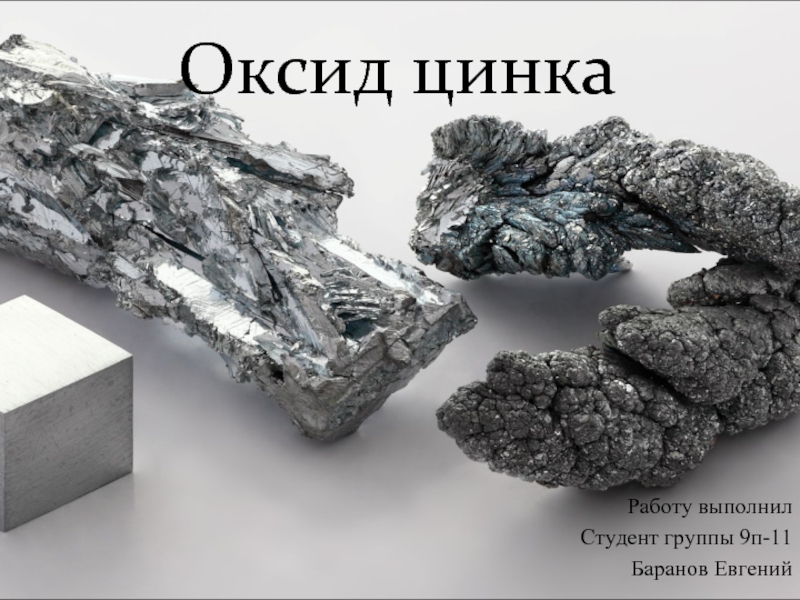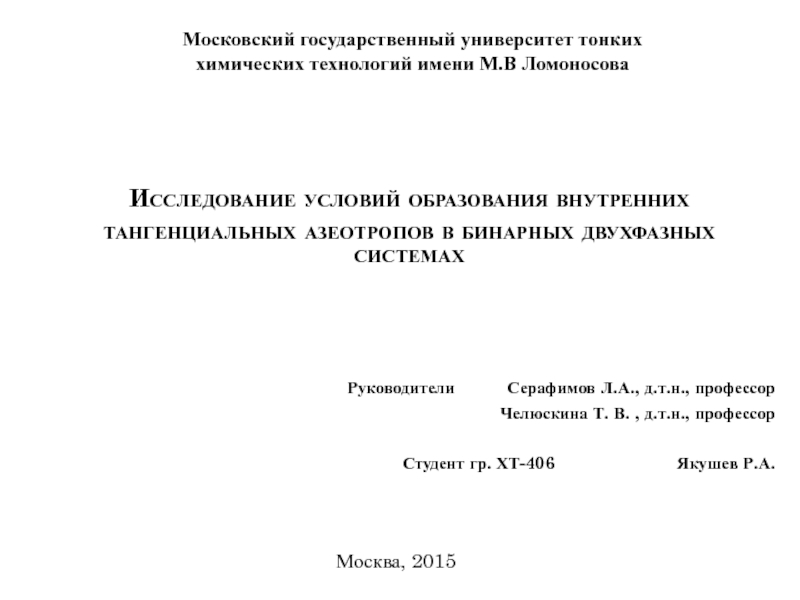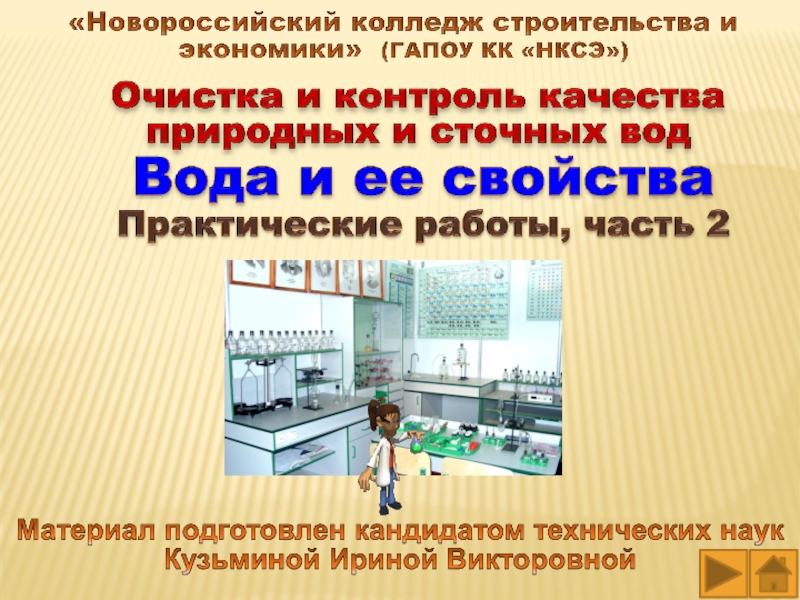- Главная
- Разное
- Дизайн
- Бизнес и предпринимательство
- Аналитика
- Образование
- Развлечения
- Красота и здоровье
- Финансы
- Государство
- Путешествия
- Спорт
- Недвижимость
- Армия
- Графика
- Культурология
- Еда и кулинария
- Лингвистика
- Английский язык
- Астрономия
- Алгебра
- Биология
- География
- Детские презентации
- Информатика
- История
- Литература
- Маркетинг
- Математика
- Медицина
- Менеджмент
- Музыка
- МХК
- Немецкий язык
- ОБЖ
- Обществознание
- Окружающий мир
- Педагогика
- Русский язык
- Технология
- Физика
- Философия
- Химия
- Шаблоны, картинки для презентаций
- Экология
- Экономика
- Юриспруденция
Coordination compounds презентация
Содержание
- 1. Coordination compounds
- 2. in analytical chemistry; for allocation of chemical
- 3. According to their contents, chemicals are
- 4. According to this theory, in each
- 5. The structure of coordination compounds Potassium
- 6. Coordination theory of coordination compounds (A. Werner,
- 7. Complex compounds : Coordination compounds (complexing ion+
- 8. 2. Classification and nomenclature of coordination compounds
- 9. Nomenclature of coordinational compounds К[Co(CN)4(CO)2] - potassium
- 10. Classification of coordination compounds on different grounds
- 11. 2. According to their attachment to the
- 12. 3. By the nature of the ligands
- 13. 4. По внутренней структуре комплексного соединения
- 14. Classification of coordination compounds on different grounds
- 15. Isomerism of coordination compounds
- 16. Isomerism of coordination compounds
- 17. Isomerism of coordination compounds
- 18. Isomerism of coordination compounds
- 19. [Co(H2O)6]2+
- 20. 2. The reactions of coordination compounds. Stability of complex compounds and constant instability.
- 21. K3[Fe(CN)6] 3K+ + [Fe(CN)6]3-
- 22. Reactions of complex on the outer sphere
- 24. Complexing constants Joining the ligand
- 25. [Ag(NH3)2]+
- 26. At the same coordination number Comparison
- 27. With different coordination number
- 28. With different coordination number 3. Comparison of
- 29. The reaction of complexes with the
- 30. 3. Dilution K[AgCl2] =
- 31. Chlorophyll
- 32. Hemoglobin
- 33. Vitamin B12 cobalamin
- 34. THE APPLICATION OF COMPLEXES IN MEDICINE Substances,
- 35. -antidotes: (Dimercaprol) EDTA, Na2EDTA, Na2CaEDTA Mercaptide bond
- 36. THE APPLICATION OF COMPLEXES IN MEDICINE For
- 38. -anticancer drug: dihlorodiamminplatinum cis-isomer
- 39. The End
Слайд 2in analytical chemistry;
for allocation of chemical elements;
in galvanotechnics;
for corrosion control;
in the
In deactivation practice;
for indication of toxic compounds;
for production of substances with predetermined properties as catalysts.
Processes of formation and destruction of complexes are used:
Слайд 3 According to their contents, chemicals are divided into simple substances
In the late nineteenth century even more complex in structure and composition molecular compounds were produced, they are called complex or coordination compounds.
DEFINITIONS:
Coordination compounds - are chemical compounds, the lattices of which consist of integrated groups formed by ions or molecules able to exist independently.
Coordination compounds - molecular compounds, the formation of which from simple substances is not associated with the occurrence of new electron pairs.
General information about coordination compounds
Слайд 4 According to this theory, in each complex compound there is
The Central ion is associated with ligands by donor-acceptor mechanism, it forms an internal area of the complex.
The Central ion is acceptor and ligands are donors of electronic pairs.
It is ionic bond between the inner and outer sphere.
Werner’s coordination theory
Alfred Werner (12.XII.1866-15.XI.1919)
The Swiss chemist. The founder of chemistry of complex (coordination) compounds. Advanced and developed (1893) coordination theory of the structure of complex compounds, disproving the concept of the constancy of numbers valence. Predicted (1899) the existence of optically active isomers, not having asymmetric carbon atom. Nobel laureate.
Слайд 5
The structure of coordination compounds
Potassium hexacyanoferrate (III)
Fe3+
CN-
CN-
CN-
CN-
CN-
CN-
K+
K+
K+
Complexing ion
ligands
The internal sphere
The outer
[ (CN)6]
К3
[Fe
→3K+
→ [Fe (CN)6]3-
Слайд 6Coordination theory of coordination compounds
(A. Werner, 1898)
Compounds of the first order
Compounds of the highest order (valence-saturated)
Fe (CN)3
+
3KCN
K3[Fe(CN)6]
CoCl3
+
6NH3
[Co(NH3)6]Cl3
BF3
+
HF
Ni
+
4CO
H[BF4]
[Ni(CO)4]
3K+
[Fe(CN)6]3-
3Cl-
[Co(NH3)6]3+
H+
[BF4]-
[Ni(CO)4]0
[CoCl (NH3)6]Cl2
[CoCO3(NH3)4] 2SO4
NH4[Cr(SCN)4(NH3)2]
Слайд 7Complex compounds :
Coordination compounds (complexing ion+ ligands)
Molecular complexes:
Quinone-hydroquinone; Hydroquinone-methanol
Inclusion compounds:
6Н2О*X,
The number of places held by each ligand in inner complex sphere is a coordination capacity of the ligand.
Monodentants ligands – coordination capacity=1 Cl-, Br-, I-, CN-, NH3
Bidentants ligands – coordination capacity=2
SO42-, CO32-, C2O42-. К3[Fe(C2O4)3]
Polydentants ligands– ligands with the coordination capacity 3,4,6.
Coordination number of the central atom in the complex is the number of electron centers ligands (atoms or p-bonds), which interact directly with the complexing agent.
Слайд 82. Classification and nomenclature of coordination compounds
Cation is named at first,
The rules of the names of coordination compounds according IUPAC:
2. In the name of the complex first list ligands (the first letters of the English alphabet), then the central atom.
3. Neutral ligands called without changes; in the names of negatively charged ligands add «o» to the end.
4. In case of several same ligands in the complex, before their name use the correct Greek numeral.
5. Name of complexing depends on the charge of the complex.
5.1. For neutral and cationic – English name of the cation
5.2. For the anionic complex - the Latin suffix «ate»
Слайд 9Nomenclature of coordinational compounds
К[Co(CN)4(CO)2] -
potassium
dicarbonyltetracyanocobaltate(ІІІ)
1) NH4SCN
+
Cr(SCN)3
+
2NH3
NH4[Cr(SCN)4(NH3)2]
ammonium
diamminetetrathiocyanatochromate(III)
2) CoCl3
+
[CoCl(NH3)5]Cl2
pentaamminechlorocobaltate(III) chloride
3) CrCl3
+
6H2O
[Cr(H2O)6]Cl3
hexaaquachromium(III) chloride
[CrCl(H2O)5]Cl2 ⋅ H2O
pentaaquachlorochromium(III) chloride monohydrate
[CrCl2(H2O)4]Cl⋅ 2H2O
Tetraaquadichlorochromium(III) chloride dihydrate
Слайд 10Classification of coordination compounds on different grounds
1. According to the sign
2. Принадлежности к определённому классу соединений
3. Природе лигандов
4. Внутренней структуре комплексного соединения
(число ядер; наличие циклов).
[Co(CN)2(NH3)4]Cl
Tetraamminedicyano-cobalt(III) chloride
Anionic
K4[Fe(CN)6]
Potassium hexacyanoferrate(II)
Neutral
[Ni(CO)4]
Тetracarbonyl nickel(II)
Cationic
Слайд 112. According to their attachment to the definite class of compounds
complex
diamminesilver(I)
hydroxydum
acids
bases
salts
H[AuCl4]
[Ag(NH3)2]OH
K2[HgI4]
hydrogen
tetrachloroaurate(III)
potassium
tetraiodomercurate(II)
Classification of coordination compounds on different grounds
Слайд 123. By the nature of the ligands
Ammines
[Ni(NH3)6]Cl2
Aquacomplexes
[Co(H2O)6]SO4
Acidocomplexes
K[Cu(CN)2]
Карбонилы [Fe(CO)5]
Hydroxocomplexes K3[Al(OH)6
Cyanide
K4[Со(CN)6]
Carbonate
[Fe(CO3)(NH3)]Cl
Different ligands
[CoI(NH3)5]Cl2
NH4[Cr(SCN)4(NH3)2]
Carbonyls [Fe(CO)5]
Classification of coordination compounds on different grounds
Слайд 134. По внутренней структуре комплексного соединения
Моноядерные
4.2. По наличию циклов
4.1. По числу
Полиядерные
Classification of coordination compounds on different grounds
Polynuclear
[(NH3)5Cr — OH — Cr(NH3)5]Cl5
μ - hydroxo-
bis-
[pentaamminechromium (III)]
chloride
Iso- and heteropoly acid
H2Cr2O7
H2[O3Cr — O — CrO3]
hydrogen
μ-oxo-bis-
[trioxochromate(VI)]
Н2Si2O5
H2[O2Si−O−SiO2]
hydrogen
μ-oxo-bis-
[dioxosilicate(IV)]
phosphorus-molibdenum
H3PO4 ∙ 12MoO3 ∙ nH2O
phosphorus-wolframium H3PO4 ∙ 12WO3 ∙ nH2O
silicicium-molibdenum H4SiO4 ∙ 12MoO3 ∙ nH2O
silicium-wolframium H4SiO4 ∙ 12WO3 ∙ nH2O
borum-wolframium H3BO3 ∙ 12WO3 ∙ nH2O
Слайд 14Classification of coordination compounds on different grounds
The presence or absence of
Simple
Fe4[Fe(CN)6]3
Prussian blue
Fe3[Fe(CN)6]2
Turnbull's blue
cyclic
Chelates
2+
[(bis-ethilendiamin)copper(II)] cation
Chelate compounds
dimethylglyoksimate nickel (II)
Слайд 15Isomerism of coordination compounds
Coordination isomerism is different allocation of ligand
[Co(NH3)6]∙[Cr(CN)6] and [Cr(NH3)6]∙[Co(CN)6].
The first compound gives sediment Ag3[Cr(CN)6], and the second - sediment Ag3[Co(CN)6].
Слайд 16Isomerism of coordination compounds
Geometric isomerism (CIS-TRANS isomerism) is different spatial
cis-[CoCl2(NH3)4]+
trans-[CoCl2(NH3)4]+
Слайд 17Isomerism of coordination compounds
Optical isomerism. Optical isomerism characterized by the
Λ-[Fe(ox)3]3−
Δ-[Fe(ox)3]3−
Слайд 18Isomerism of coordination compounds
Structural isomerism
Hydrated (solvation) isomerism is different allocation
[Cr(H2O)Cl2]Cl ∙ 2H2O (dark green).
Ionization isomerism is determined by the different distribution of charged ligands between internal and external spheres of the complex. Examples of compounds: [Co(NH3)5Br]SO4 (red-purple),
[Co(NH3)5SO4]Br (red).
Слайд 19
[Co(H2O)6]2+ pink
[Co(CH3COO)2] hot pink
[Co(NH3)6]2+ brownish-pink
Amplification of a field of ligands
Influence of the ligand field on coloring of the complexes
Слайд 202. The reactions of coordination compounds.
Stability of complex compounds and constant
Слайд 21K3[Fe(CN)6] 3K+ + [Fe(CN)6]3-
[Ag(NH3)2]Cl [Ag(NH3)2]+ + Cl-
Dissociation of the CC on the external sphere (primary dissociation)
Слайд 22Reactions of complex on the outer sphere
2K3[Fe(CN)6] + 3FeSO4 = Fe3[Fe(CN)6]2↓
[CoCl2(NH3)4]Cl + AgNO3 = [CoCl2(NH3)4]NO3 + AgCl↓
K4[Fe(CN)6] + 4HCl = H4[Fe(CN)6] + 4KCl
H2[PtCl6] + 2CsOH = Cs2[PtCl6] + 2H2O
Fe4[Fe(CN)6]3 + 12 KOH = 4Fе(OH)3↓ + 3K4[Fe(CN)6]
Слайд 23
Br-
Cu2+ [CuBr]+ [CuBr2] [CuBr4]2-
+ H2O + H2O + H2O
Stepped formation and dissociation bromide complexes of copper(II)
green brown cherry
Слайд 24Complexing constants
Joining the ligand L to the ion (atom) -
M + L = ML
If the complex is formed, then the equilibrium constant is called the formation constant:
For the reaction of complex formation MLn:
M + nL = MLn
Total formation constant:
The inverse of formation constant is called the instability constant (Кinstab.=β-1) since it characterizes the ability of the complex to dissociate:
[MLn] = M + nL
Слайд 25[Ag(NH3)2]+ [Ag(NH3)]+ + NH3
[Ag(NH3)2]+
Dissociation of the CC the inner sphere (secondary dissociation)
Слайд 26At the same coordination number
Comparison of the strength of the complexes
[Fe(SCN)6]3- + 6 F- = 6 SCN- + [FeF6]3-;
[FeF6]3- + Al3+ = Fe3+ + [AlF6]3-
Слайд 28With different coordination number
3. Comparison of the stability of the complexes
Слайд 29 The reaction of complexes with the destruction of the complex 1.
Слайд 303. Dilution
K[AgCl2] = KCl + AgCl↓
5. Red-ox reactions
2K3[Cr(ОH)6]
4. Heating
t0
K3[Cr(ОH)6] = 3KOH + Cr(OH)3↓
2. The formation of poorly soluble compound
[Ag(NH3)2]NO3 + KI = AgI↓ + 2NH3 + KNO3
Слайд 34THE APPLICATION OF COMPLEXES IN MEDICINE
Substances, eliminating effects of poisons on
One of the first antidotes that is used in chelation therapy is British anti-lewisite (Dimercaprol)
This drug effectively removes arsenic, mercury, chromium and bismuth from the body . The use of drugs of this series is based on the formation of more stable complexes with metal ions than the complexes of these ions with sulfur-containing groups of proteins, amino acids and carbohydrates.
Слайд 36THE APPLICATION OF COMPLEXES IN MEDICINE
For the lead removing using preparations
Tetatsin are introduced into the organism in the form of 5-10% solution on the basis of physiological solution. For binding poison that is in the stomach, tetatsin lavage is used. The drug is effective and fast acting in inhaled administration method. It is rapidly absorbed and circulates in the blood for a long time. Furthermore, tetatsin is used for protection of gas gangrene. It inhibits the action of zinc and cobalt ions, which are activators of the enzyme lecithinase, which is a gas gangrene toxin.
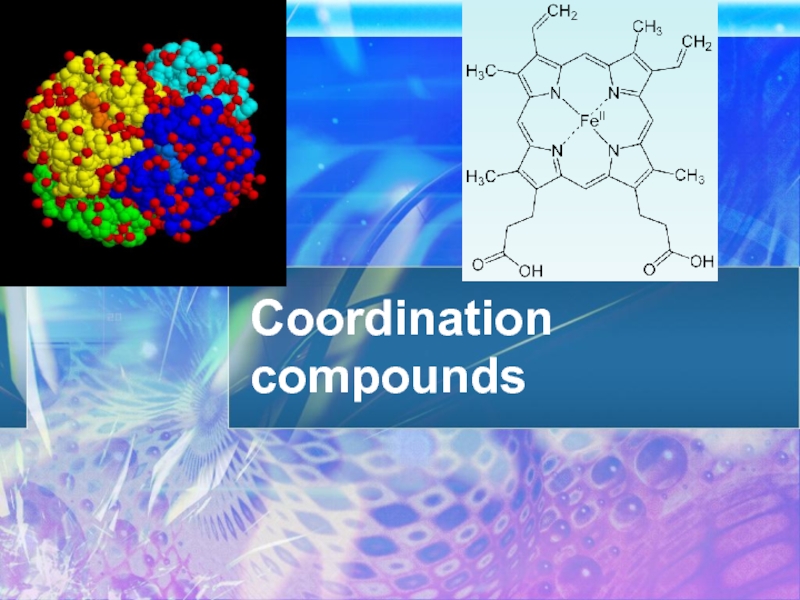
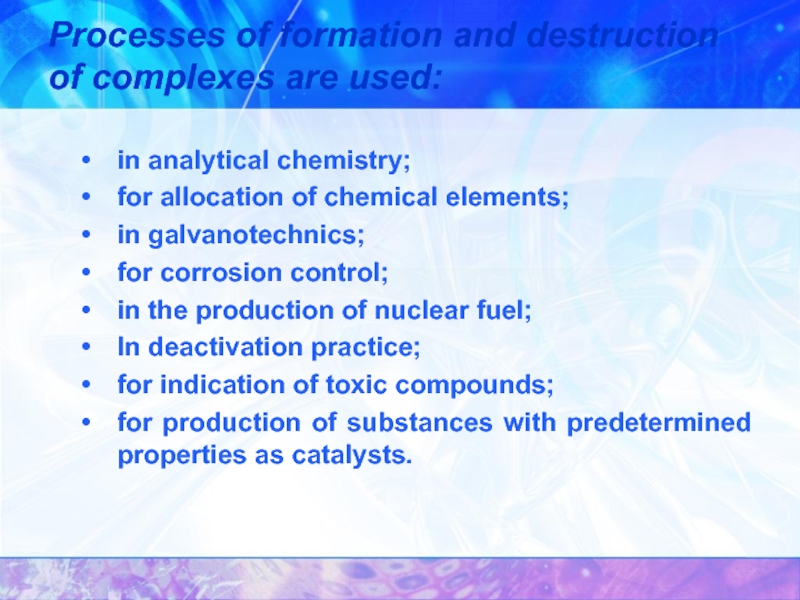
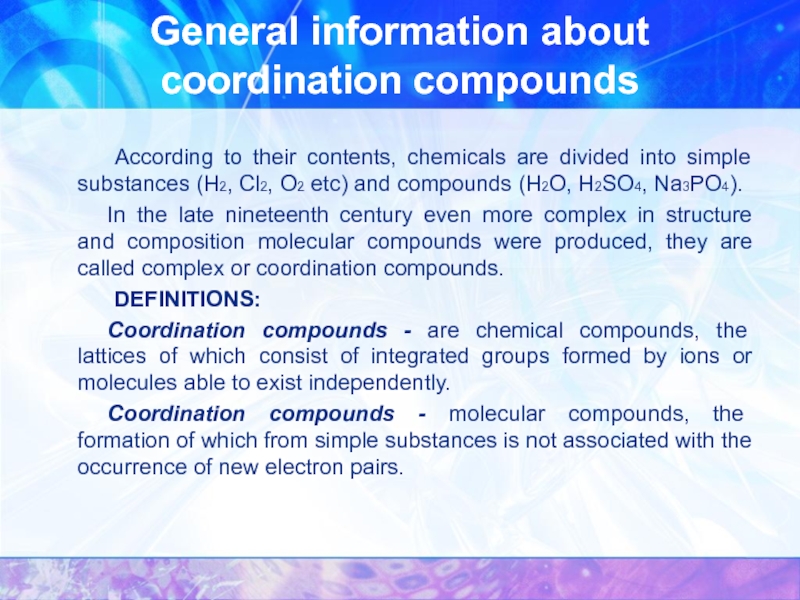
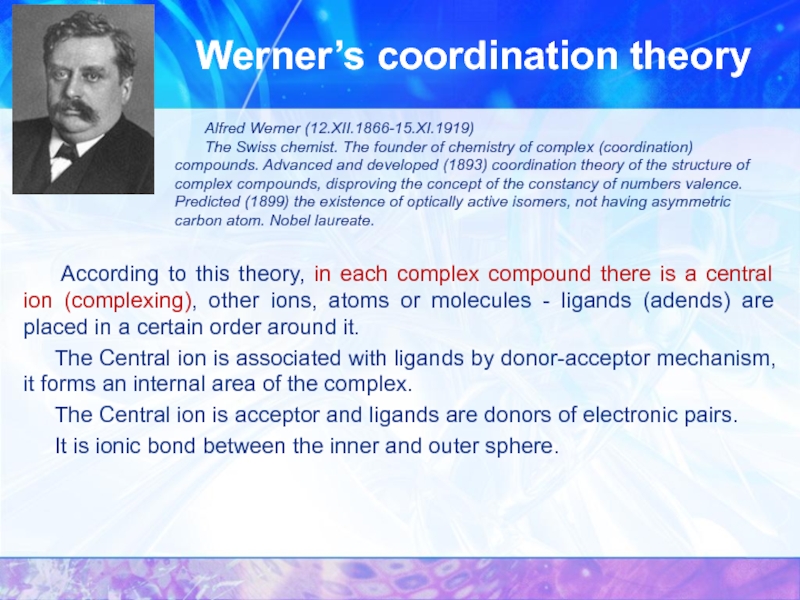
![The structure of coordination compoundsPotassium hexacyanoferrate (III)Fe3+CN-CN-CN-CN-CN-CN-K+K+K+Complexing ionligandsThe internal sphereThe outer sphere[ (CN)6]К3[Fe→3K+→ [Fe (CN)6]3-](/img/tmb/5/466919/6660ed5b8aa65c0376a95c24f07da434-800x.jpg)
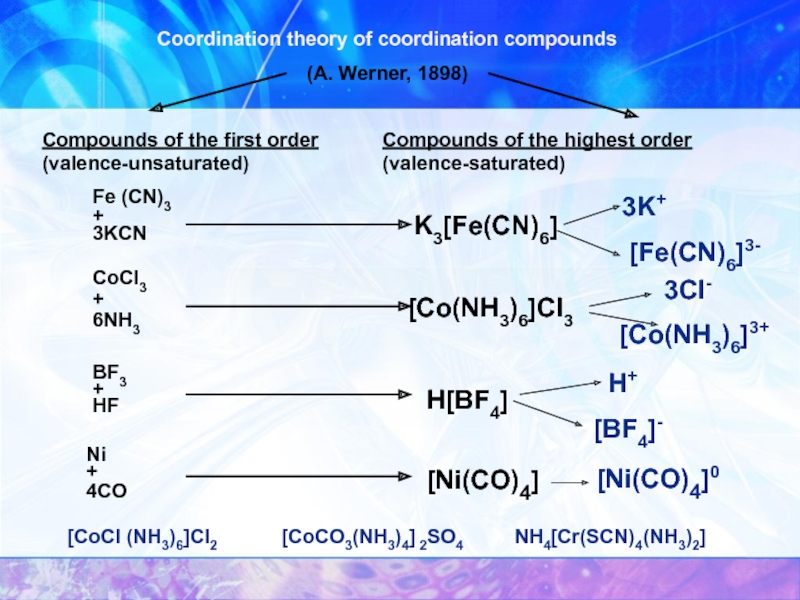
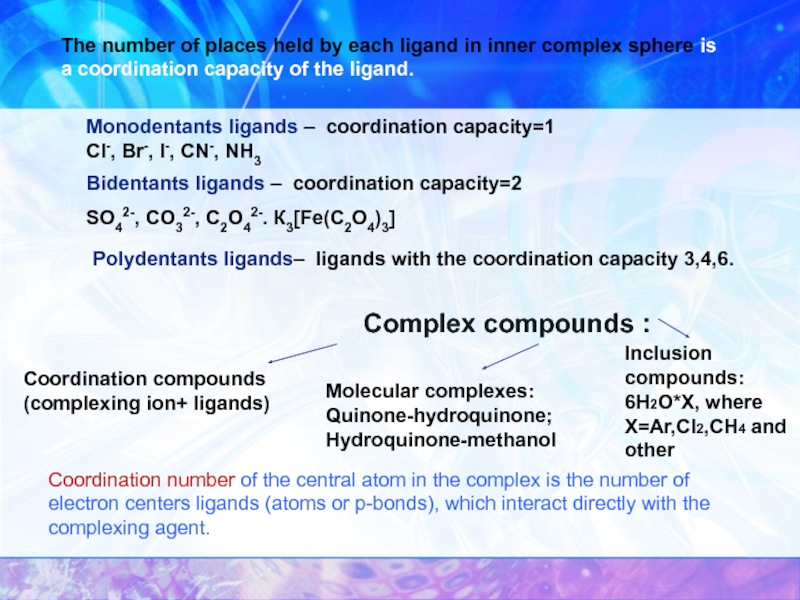
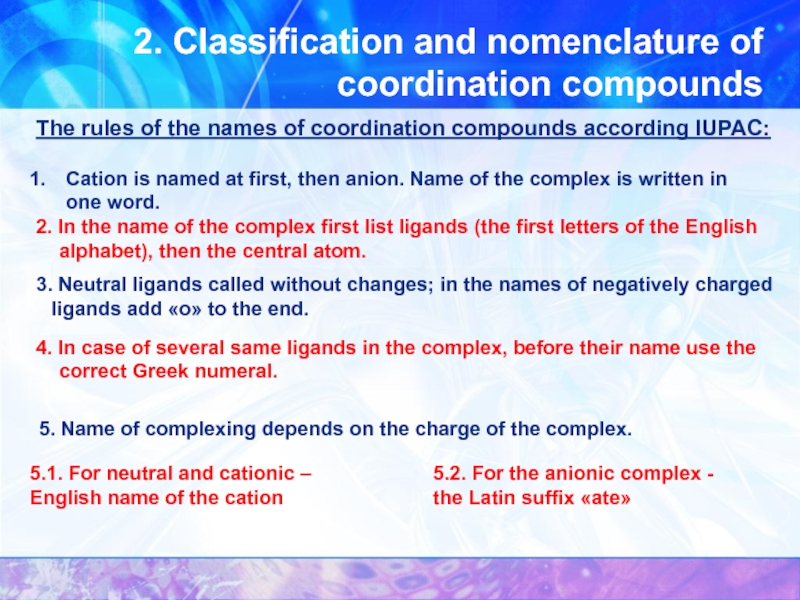
![Nomenclature of coordinational compoundsК[Co(CN)4(CO)2] -potassiumdicarbonyltetracyanocobaltate(ІІІ)1) NH4SCN+Cr(SCN)3+2NH3NH4[Cr(SCN)4(NH3)2] ammonium diamminetetrathiocyanatochromate(III) 2) CoCl3+ 5NH3 [CoCl(NH3)5]Cl2pentaamminechlorocobaltate(III) chloride3) CrCl3+ 6H2O[Cr(H2O)6]Cl3hexaaquachromium(III) chloride](/img/tmb/5/466919/c0db75459313a4396791faab9950af90-800x.jpg)
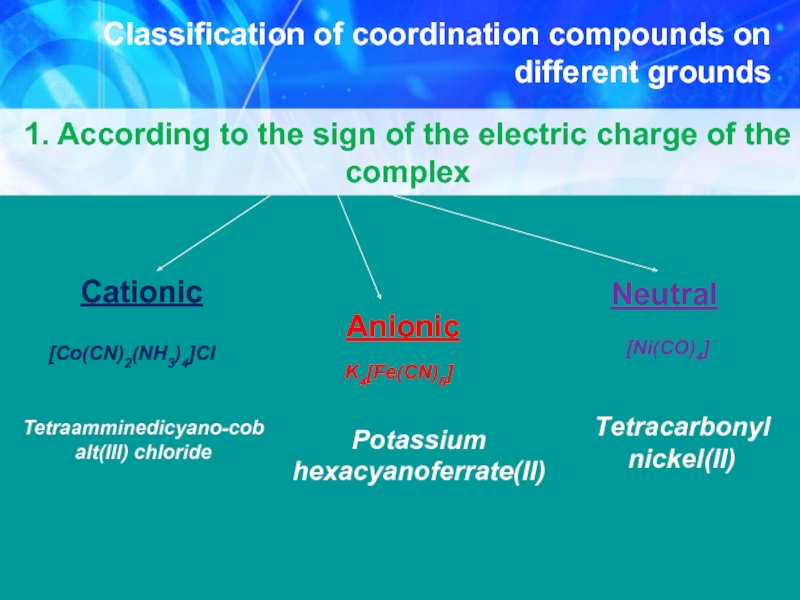
![2. According to their attachment to the definite class of compoundscomplexdiamminesilver(I) hydroxydumacidsbases saltsH[AuCl4][Ag(NH3)2]OHK2[HgI4]hydrogentetrachloroaurate(III) potassiumtetraiodomercurate(II)Classification of coordination](/img/tmb/5/466919/4a7305d8b14d39dbbde58d75f1e6c380-800x.jpg)
![3. By the nature of the ligandsAmmines[Ni(NH3)6]Cl2 Aquacomplexes[Co(H2O)6]SO4 AcidocomplexesK[Cu(CN)2]Карбонилы [Fe(CO)5]Hydroxocomplexes K3[Al(OH)6 ]CyanideK4[Со(CN)6]Carbonate[Fe(CO3)(NH3)]ClDifferent ligands[CoI(NH3)5]Cl2NH4[Cr(SCN)4(NH3)2]Carbonyls [Fe(CO)5]Classification of](/img/tmb/5/466919/688217f576b612e861e3d3021b4a6a5d-800x.jpg)
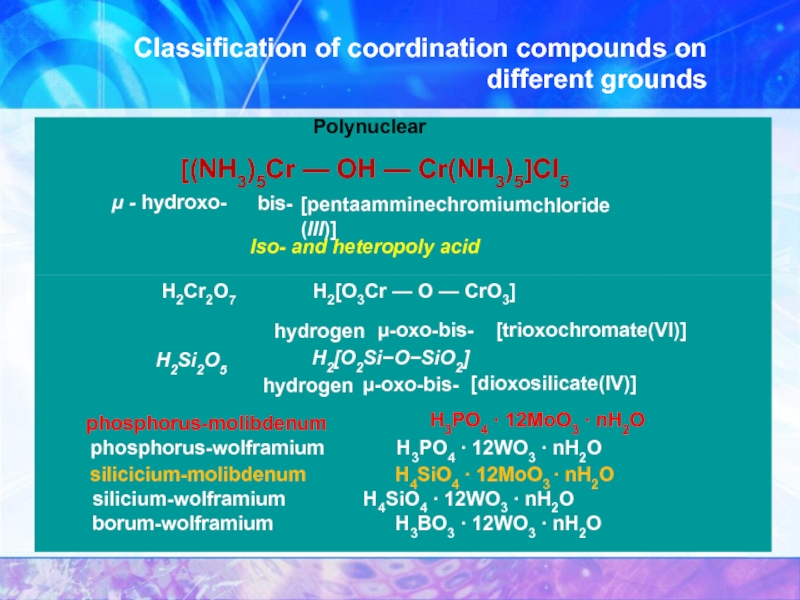
![Classification of coordination compounds on different groundsThe presence or absence of cyclesSimpleFe4[Fe(CN)6]3Prussian blueFe3[Fe(CN)6]2Turnbull's bluecyclicChelates2+ [(bis-ethilendiamin)copper(II)]](/img/tmb/5/466919/cc8f41bc71941768357f3bc51d832925-800x.jpg)

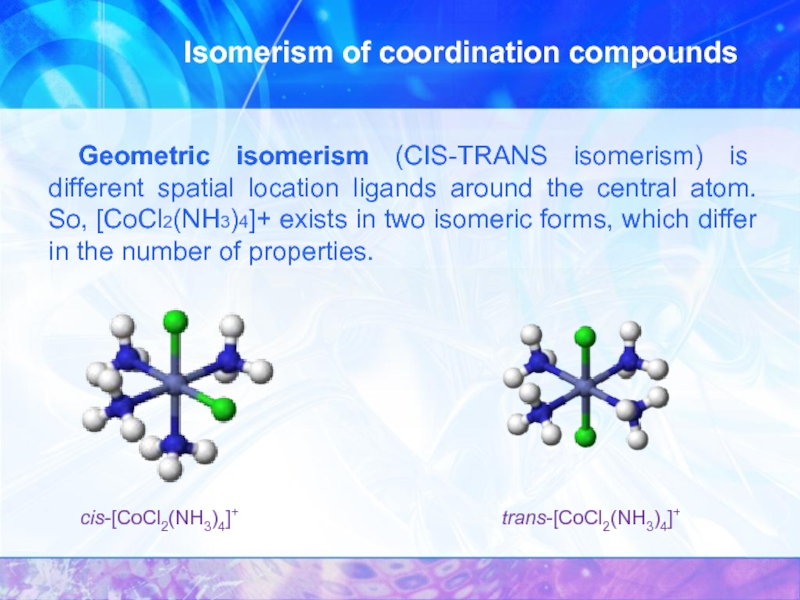
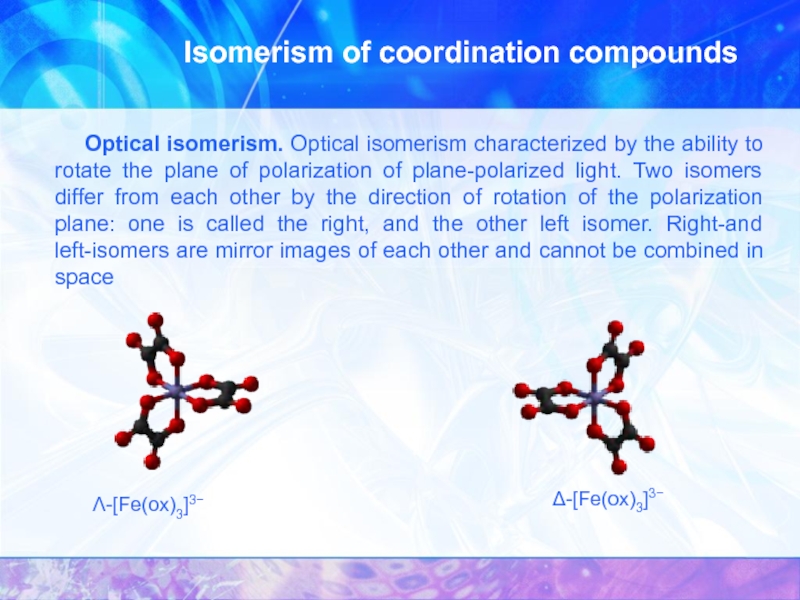
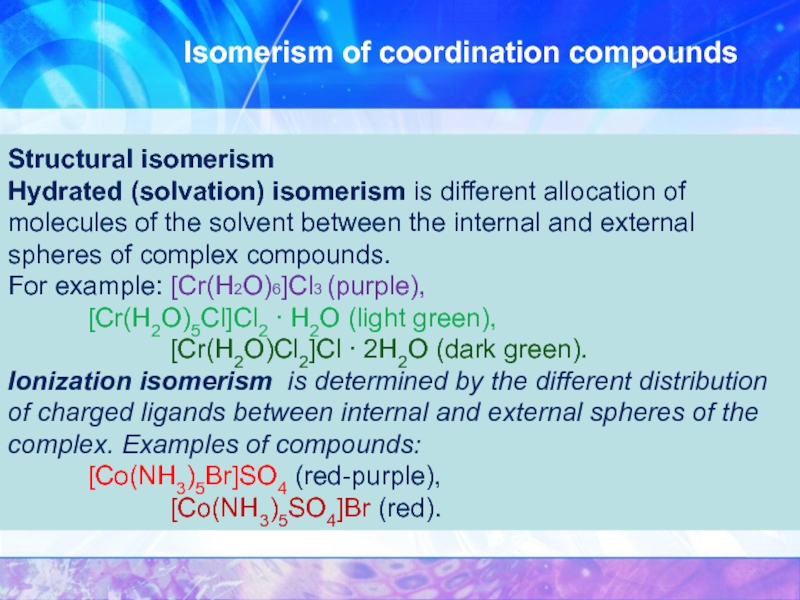
![[Co(H2O)6]2+ pink[Co(CH3COO)2] hot pink [Co(NO2)6]4- orange[Co(NH3)6]2+ brownish-pinkAmplification of a field](/img/tmb/5/466919/a8ec37fe6a4c66e5824c260783f5535c-800x.jpg)
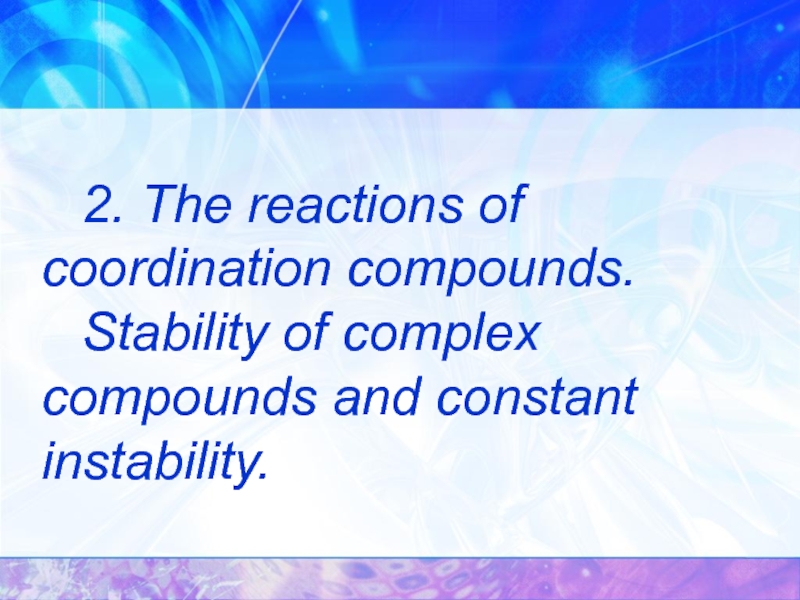
![K3[Fe(CN)6] 3K+ + [Fe(CN)6]3- [Ag(NH3)2]Cl [Ag(NH3)2]+ + Cl-Dissociation of the](/img/tmb/5/466919/a8d7bfdbd7f643e27a40147ea5cd15cd-800x.jpg)
![Reactions of complex on the outer sphere2K3[Fe(CN)6] + 3FeSO4 = Fe3[Fe(CN)6]2↓ + 3K2SO4[CoCl2(NH3)4]Cl + AgNO3](/img/tmb/5/466919/981a05ef9eef4eafd9d3acca55837b55-800x.jpg)
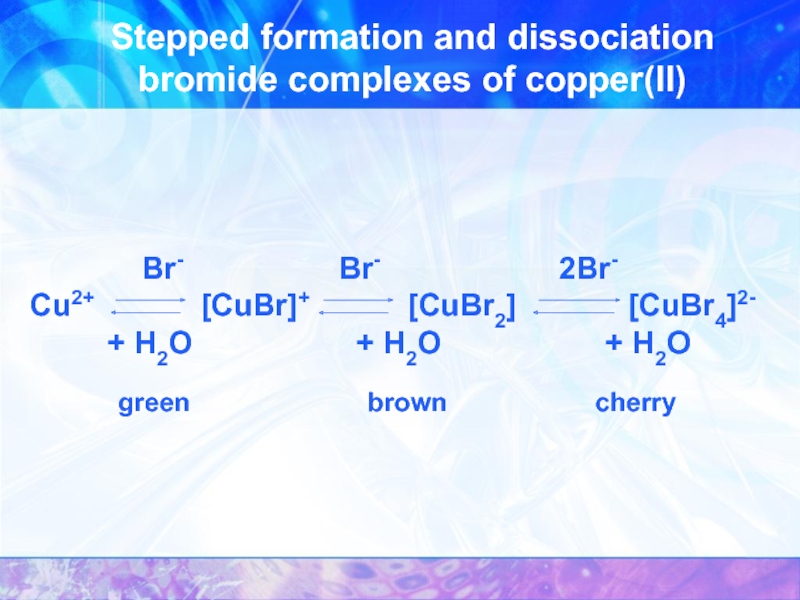
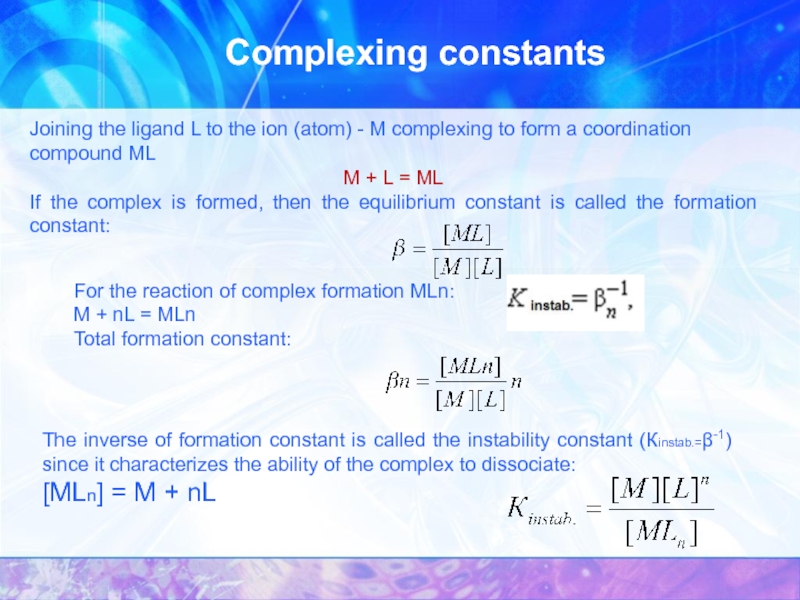
![[Ag(NH3)2]+ [Ag(NH3)]+ + NH3[Ag(NH3)2]+ Ag+ + 2 NH3Dissociation of the CC](/img/tmb/5/466919/1e760993247037e0cf349ce1839329fa-800x.jpg)
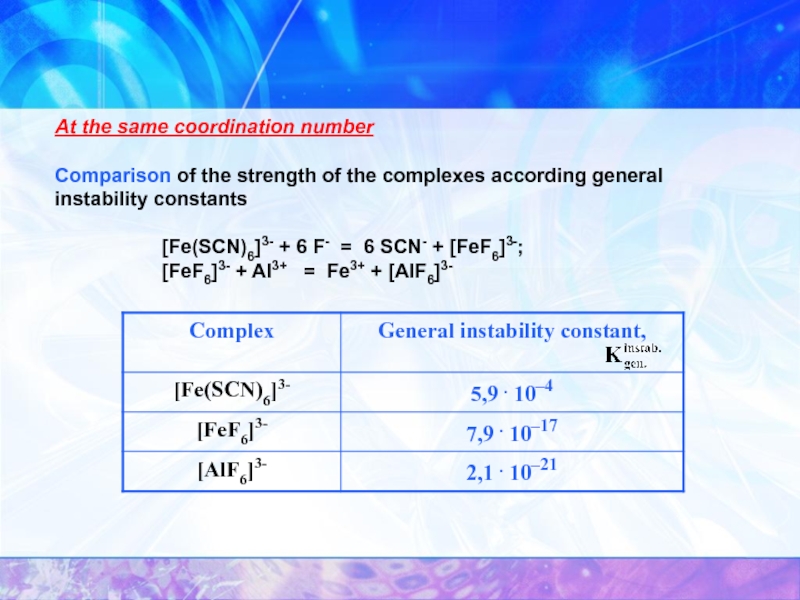
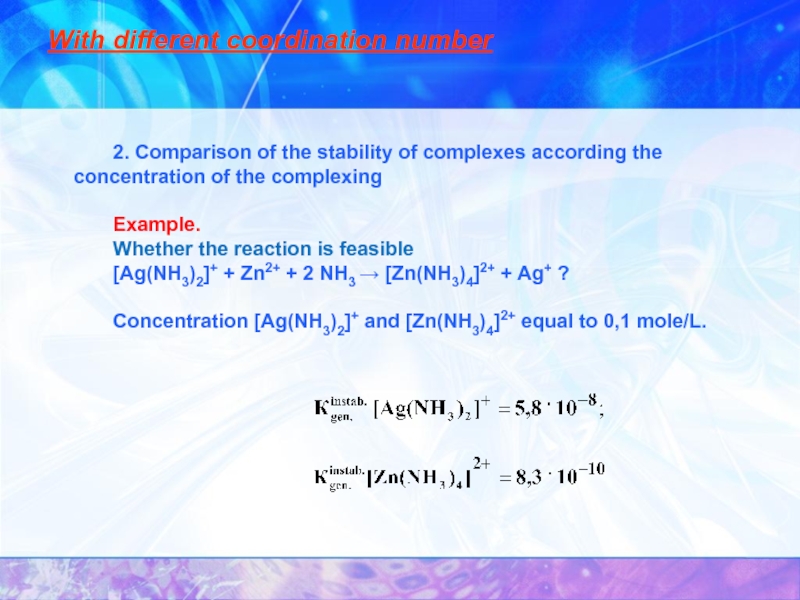
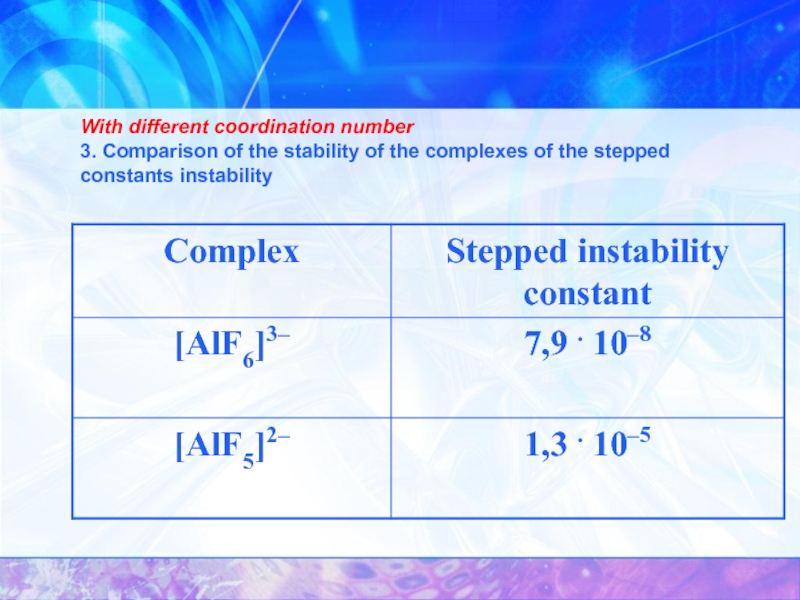
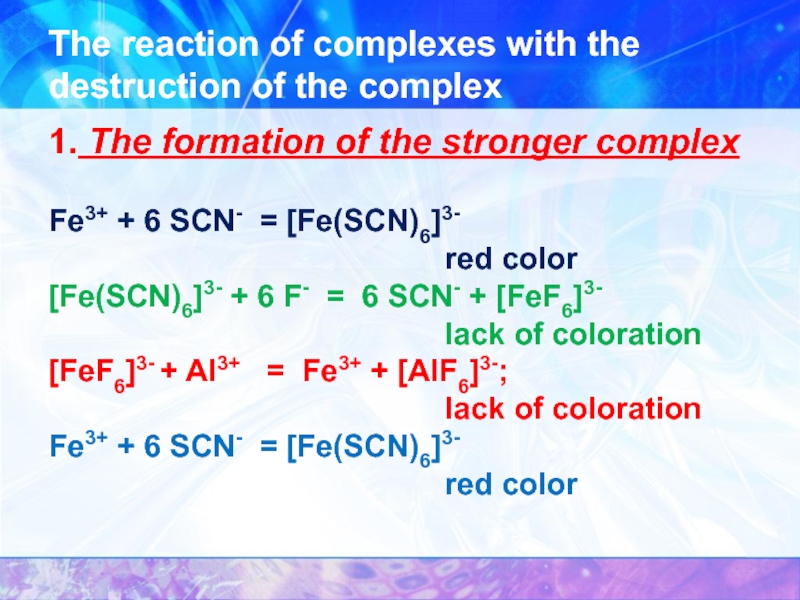
![3. DilutionK[AgCl2] = KCl + AgCl↓ 5. Red-ox reactions2K3[Cr(ОH)6] + 3Сl2 + 4KOH = 2K2CrO4](/img/tmb/5/466919/243d7a28db0e51e4ab50aa1a980fcc6b-800x.jpg)
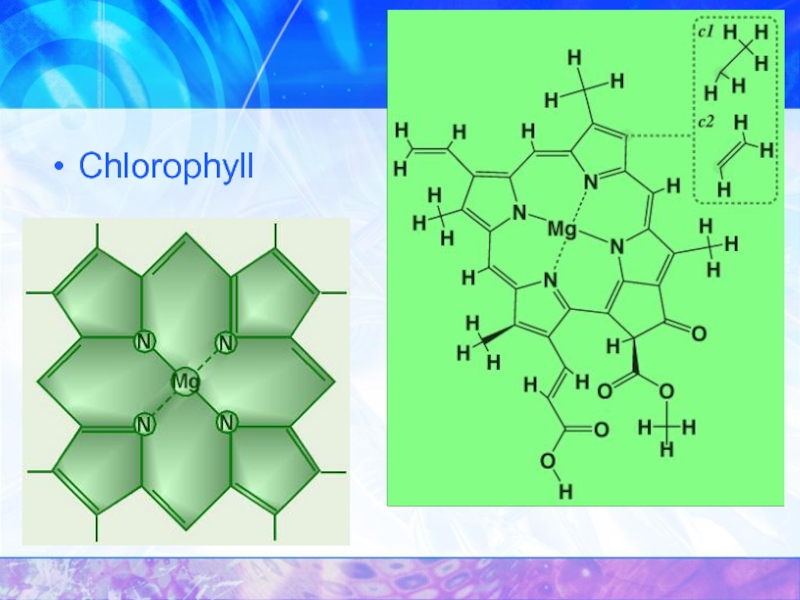
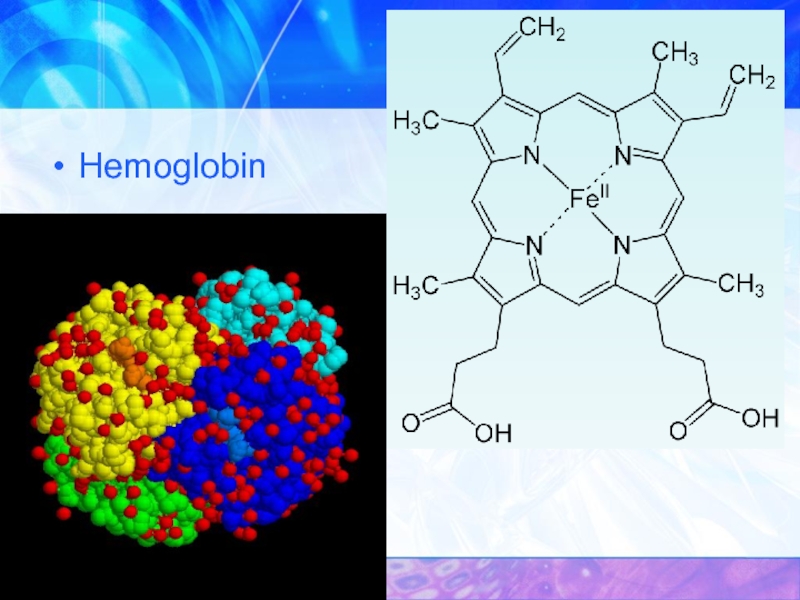
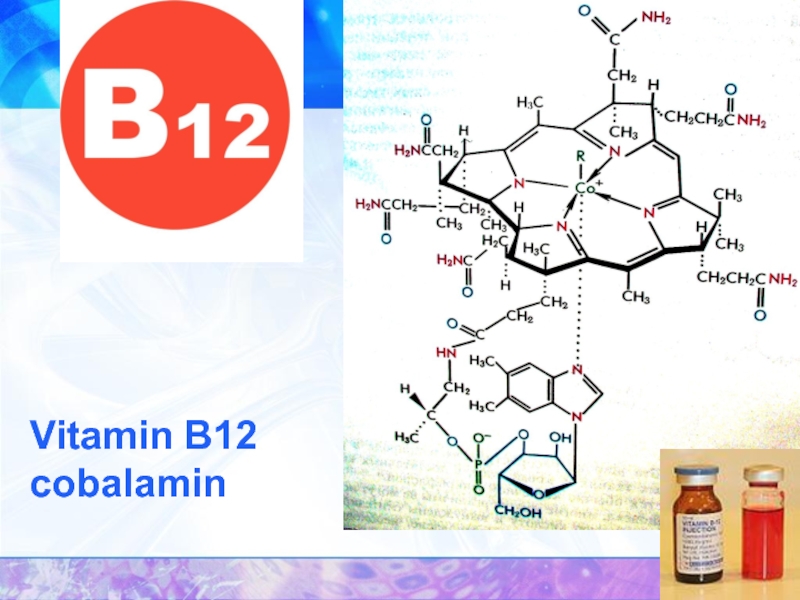

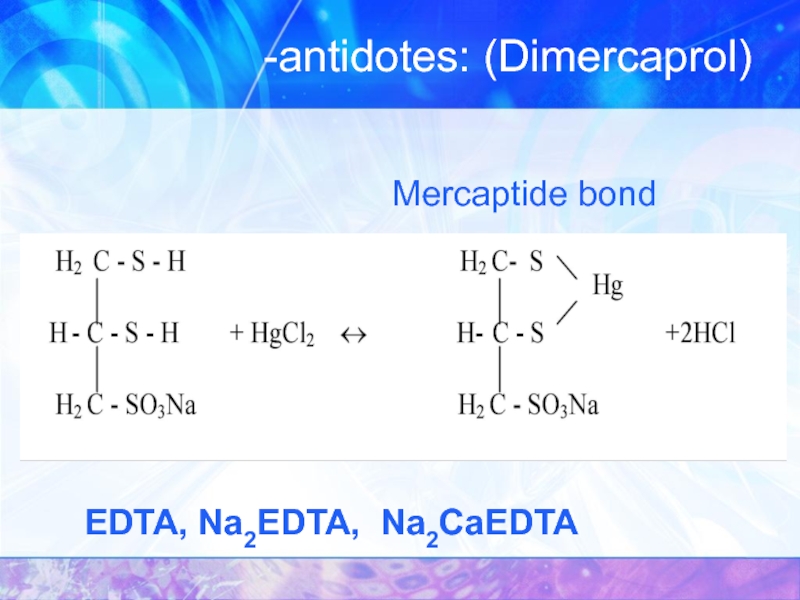
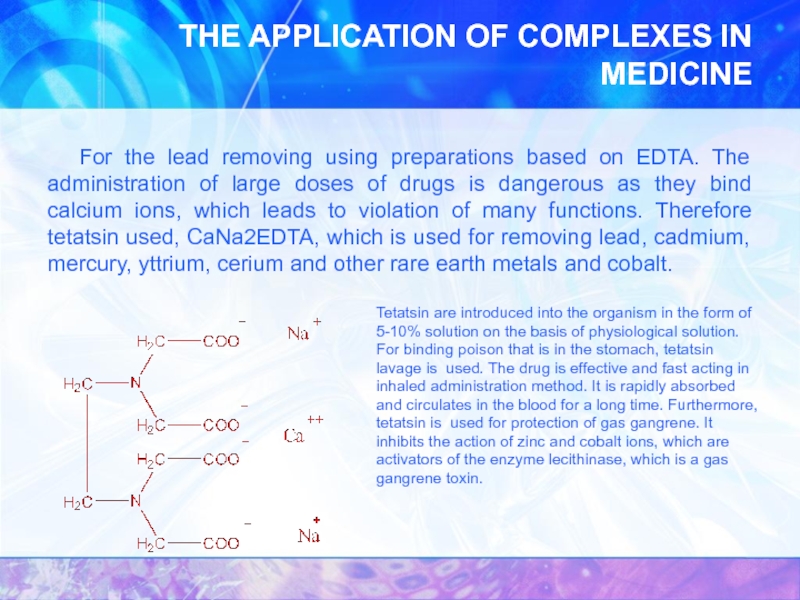
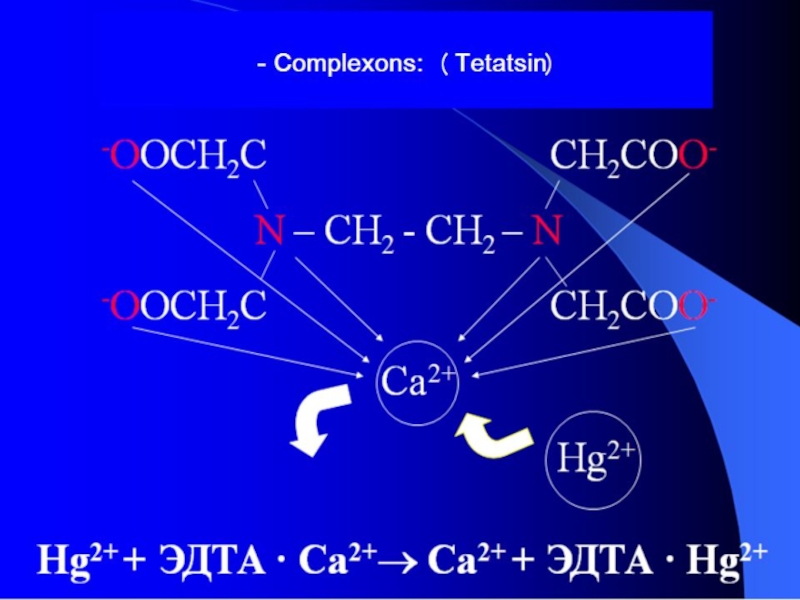
![-anticancer drug: dihlorodiamminplatinum cis-isomer (cis-platin) cis- [Pt(NH3)2Cl2] cis- [Pt(NH3)4Cl2]](/img/tmb/5/466919/a8086714c0ff8942786f3616747a11e6-800x.jpg)

